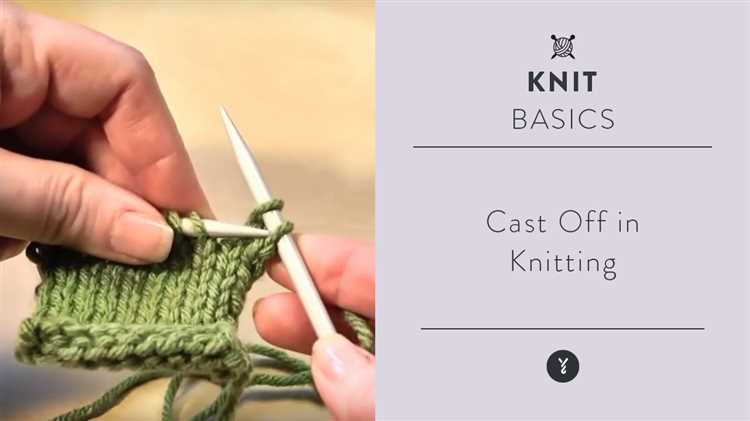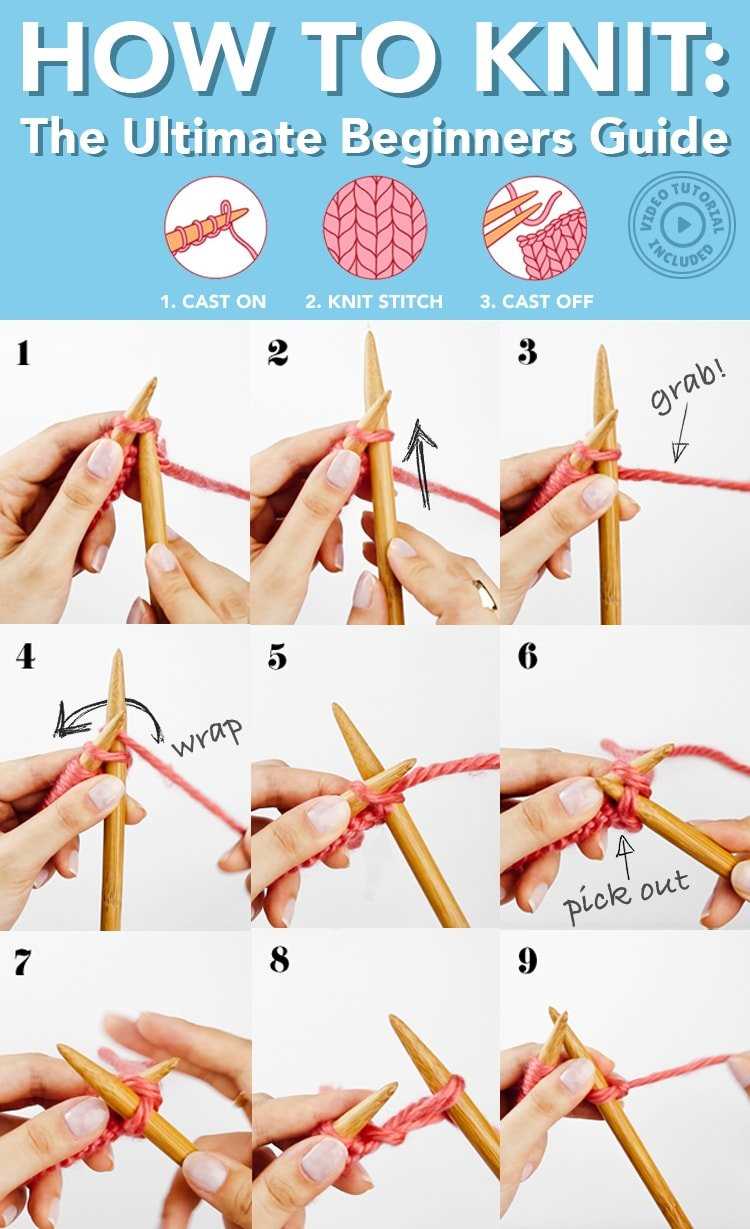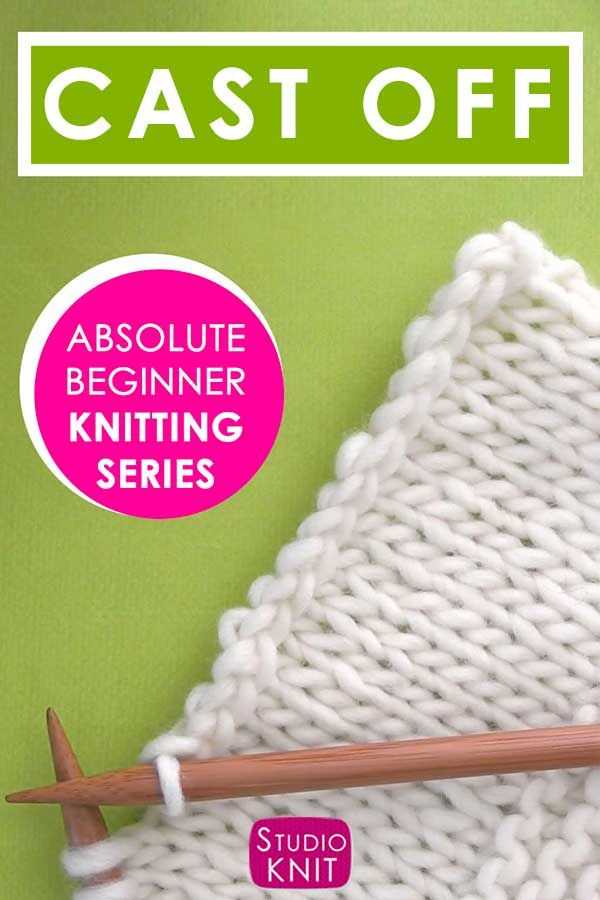Are you a beginner knitter looking to expand your skills? Or maybe you’ve been knitting for a while but want to add a new technique to your repertoire. Casting off, also known as binding off, is an essential skill for any knitter and is used to finish off a piece.
In this article, we will guide you through the process of casting off a knit stitch with easy step-by-step instructions. With a little practice, you’ll be able to confidently cast off your projects and create a neat and professional finish.
To cast off a knit stitch, you’ll need a pair of knitting needles and a project with completed rows. It’s important to have a firm grasp on the basic knit stitch before attempting to cast off. Once you’ve reached the end of your row, follow these simple steps to cast off:
- Insert your right needle into the first stitch on your left needle as if to knit.
- Knit the first stitch onto your right needle, leaving both stitches on your right needle.
- Insert the left needle into the first stitch on your right needle.
- Pass the first stitch over the second stitch and off the needle.
Repeat these steps until you are left with one stitch on your right needle. Cut the yarn, leaving a tail that is long enough to weave in later, and pull it through the last stitch to secure it. Congratulations! You have successfully cast off a knit stitch.
This casting off technique is perfect for finishing off scarves, blankets, and other flat projects. By following these step-by-step instructions, you can achieve a tidy edge that won’t unravel.
Now that you’ve mastered the basics of casting off a knit stitch, you can explore different variations and experiment with different techniques. Remember, practice makes perfect, so keep knitting and continue to challenge yourself with new projects. Happy knitting!
What is a cast off in knitting?
In the world of knitting, a cast off, also known as binding off, is the process of finishing a knitted project by securing the stitches and creating a neat edge. It is the opposite of casting on, which is the process of starting a new knitting project.
When you cast off, you are essentially removing the stitches from the knitting needle, while still maintaining the structure of the knitted fabric. This is done by working the stitches in a specific way that ensures they will not unravel.
The cast off technique is commonly used to create a finished edge on various knitting projects, such as scarves, sweaters, socks, and blankets. It not only adds a polished look to the project but also prevents the stitches from unraveling over time.
There are different methods of casting off, depending on the desired result and the pattern instructions. Some common cast off techniques include the basic bind off, the stretchy bind off, and the picot bind off.
Regardless of the method used, the main goal of a cast off is to securely finish the knitted project and create a clean edge that won’t come undone. It is an essential skill for every knitter to learn and master.
| Advantages |
|---|
| Creates a finished edge |
| Prevents stitches from unraveling |
| Adds a polished look to the project |
| Securely finishes the knitted project |
The importance of casting off correctly
When it comes to knitting, casting off correctly is just as important as casting on. It is the final step in completing your knitting project and can greatly affect the final appearance and structure of your work. Here are a few reasons why casting off correctly is important:
- Preventing unraveling: When you cast off, you create a secure edge that prevents your stitches from unraveling. This is especially important for projects like scarves and sweaters that will be frequently worn and washed.
- Create a neat finish: A proper cast off creates a neat and even edge, giving your finished knitting project a polished look. It ensures that all the stitches are securely bound off and there are no loose or uneven stitches.
- Maintaining tension: Casting off too tightly or too loosely can affect the tension of your knitting. If the cast off is too tight, it can cause the edge to pucker. If it is too loose, it can create a floppy edge. Maintaining proper tension when casting off is crucial for achieving a professional-looking finish.
- Preparing for blocking: Blocking is the process of wetting or steaming your knitting project to shape it and even out any irregularities. When you cast off correctly, it becomes easier to block your work effectively and ensure that it retains its shape.
- Setting boundaries: Casting off defines the boundaries of your knitted piece. It marks the end of one section and allows you to move on to the next phase or stitch pattern. It is an essential step in following knitting patterns and creating intricate designs.
Overall, casting off correctly is essential for both the aesthetic appearance and structural integrity of your knitting projects. By taking the time to learn and master this technique, you can enhance the quality and longevity of your hand-knit items.
Step 1: Prepare your knitting
Before you begin casting off a knit stitch, make sure you have completed the desired number of rows or stitches on your knitting project. Take a moment to double-check your work to ensure there are no mistakes or dropped stitches.
You should have your knitting project on your needles, with the working yarn attached to the last stitch. If you have multiple stitches on your needle, make sure they are all knit stitches. If you have any purl stitches, you will need to cast off using a different method.
Next, gather any necessary materials for casting off, such as a tapestry needle or crochet hook, depending on the method you choose. It is also helpful to have a pair of scissors nearby in case you need to trim the yarn after casting off.
Step 2: Insert the right needle
- Hold the left needle with the stitches in your left hand, and take the right needle in your right hand.
- Insert the right needle into the first stitch on the left needle, from left to right, going through the front loop of the stitch.
- Make sure to insert the right needle under the left needle, and not over it.
- Keep a firm grip on the left needle to ensure that the stitches do not slip off.
Step 3: Knit the first 2 stitches
Now that you have successfully cast on your stitches and completed the setup row, it’s time to start knitting!
1. Hold the knitting needle with the cast-on stitches in your right hand and the empty needle in your left hand.
2. Insert the empty needle into the first stitch on the right-hand needle, going from left to right.
3. With the yarn in the back, use your right hand to wrap the yarn counterclockwise around the right-hand needle.
4. Using the right-hand needle, pull the loop of yarn through the first stitch, creating a new stitch on the left-hand needle.
5. Repeat steps 2-4 to knit the second stitch.
6. Now you have successfully knit the first 2 stitches!
Step 4: Pass the first stitch over the second one
Once you have casted on all your stitches and completed your knit row, it is time to begin the casting off process. The first step in casting off is passing the first stitch over the second one. This creates a clean edge on your finished piece.
- Insert your right-hand needle into the first stitch on the left-hand needle, as if you were going to knit.
- Use the right-hand needle to lift the first stitch up and over the second stitch on the left-hand needle.
- Gently slide the first stitch off the left-hand needle, leaving only the second stitch on the right-hand needle.
- Continue this process, knitting one stitch and passing the previous stitch over it, until you have reached the end of your row.
As you cast off each stitch, you will notice that the edge of your work starts to form a neat and even line. This creates a polished finish to your knitting project.
Step 5: Continue casting off
Once you have successfully cast off the first stitch, you will repeat the process until you have cast off all of the stitches on your needle.
Here’s how to continue casting off:
- Insert your right needle into the next stitch on the left needle as if to knit.
- Knit this stitch by bringing the yarn over the right needle from back to front and pulling it through the stitch.
- With both stitches on the right needle, use your left needle to lift the first stitch you knitted over the second stitch and off the right needle.
- One stitch has now been cast off. Repeat steps 1-3 until all stitches have been cast off.
Remember to keep your tension even as you knit each stitch and cast them off. This will help create a neat and consistent edge on your knitting project.
Casting off can be a bit tricky at first, but with practice, it will become easier. Don’t be afraid to take your time and go slowly as you learn. Before you know it, you’ll be casting off like a pro!
Step 6: Finish casting off and secure the stitch
Once you have cast off all the stitches except for the last one on the right needle, it’s time to finish the casting off process and secure the stitch.
- Knit two stitches. To start finishing the casting off process, knit the first two stitches on the left needle together. Insert the right needle into the front loops of both stitches and wrap the yarn around the needle. Pull the loop through both stitches, removing them from the left needle. This counts as one stitch cast off.
- Pass the first stitch over. Insert the left needle into the front loop of the second stitch on the right needle. Lift it up and over the first stitch and off the needle. The first stitch is now securely cast off.
- Knit one stitch. Knit the next stitch on the left needle.
- Pass the second stitch over. Insert the left needle into the front loop of the stitch on the right needle. Lift it up and over the stitch just knitted and off the needle. The second stitch is now securely cast off.
- Repeat steps 3 and 4. Continue knitting one stitch and passing the previous stitch over until you have cast off all the stitches except for the last one.
- Break the yarn and pull it through the last stitch. Once only one stitch remains on the right needle, cut the yarn, leaving a tail of about 6 inches. Thread the tail through the last stitch and gently pull to secure the stitch.
Congratulations! You have successfully cast off your knit stitch. Now you can admire your finished work and continue on to your next knitting project.
What to do if you make a mistake while casting off
If you make a mistake while casting off, don’t worry! There are a few steps you can follow to fix the mistake and continue with the casting off process.
- Identify the mistake: Take a moment to examine your work and determine where the mistake occurred. Look for any skipped stitches, extra loops, or other issues that may have caused the mistake.
- Undo the stitches: Carefully unravel the stitches back to the point of the mistake. You can use a knitting needle or your fingers to gently pull out the stitches one by one.
- Fix the mistake: Once you have reached the point of the mistake, assess what needs to be done to correct it. You may need to re-knit a few stitches or fix any errors in the pattern. Refer to your knitting instructions or seek guidance from a knitting resource if needed.
- Continue casting off: Once the mistake has been fixed, continue with the casting off process by working the remaining stitches as instructed. Pay close attention to ensure that you are completing each step correctly.
- Check your work: After you have finished casting off, take a moment to examine your work and make sure there are no additional mistakes. Look for any loose or uneven stitches and make any necessary adjustments before proceeding with your project.
Remember that making mistakes is a normal part of the learning process, and even experienced knitters occasionally make errors. Don’t be discouraged by mistakes but instead see them as opportunities to learn and improve your skills. With practice and patience, you’ll become more confident in your ability to cast off and handle any mistakes that arise.
FAQ:
What is a knit stitch?
A knit stitch is a basic stitch in knitting where the yarn is passed through the previous stitch on the needle, creating a new loop.
Why do I need to cast off a knit stitch?
You need to cast off a knit stitch to finish a knitted piece, secure the stitches, and prevent them from unraveling.
Is casting off a knit stitch difficult?
No, casting off a knit stitch is not difficult. It is a simple technique that can be easily learned with practice.
What tools do I need to cast off a knit stitch?
To cast off a knit stitch, you will need knitting needles, yarn, and scissors.


